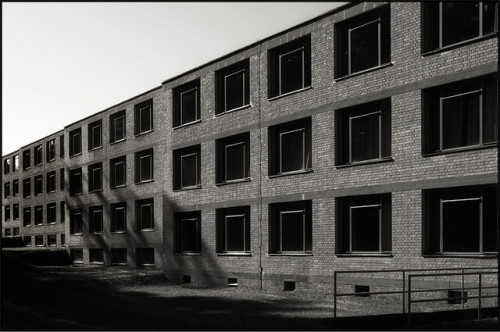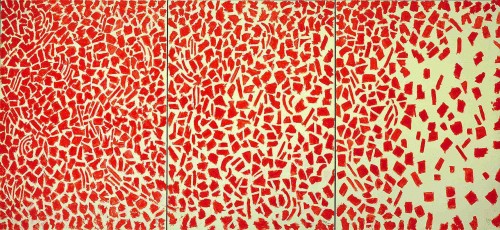
Manuel Alvarez Bravo, photography. 1931.
“…self-parody has become the life-support system of international art infrastructures. Make people feel smart, and they will put up with anything. The mindset cannot be outflanked or overturned, because it routinely performs those operations on itself.”
Peter Schjeldahl
“In the Basle orphanage where I lived from the age of nine to fourteen I had to work hard for long hours as a joiner’s apprentice when I was out of school. On Sunday I used to copy Hans Holbein’s designs for goldsmiths and in this way trained my sense of form. I am sure that Holbein’s Renaissance found a boyish and ingenuous echo in the way in which I fitted the Biedermeier chests of drawers in vogue at the time with decorative veneers. From fifteen to eighteen I worked as a stone mason during the day. In the evening I attended classes at the technical school and at night and on Sundays I worked without intermission copying Viollet-le-Duc’s work on the Gothic castle of Pierrefonds.”
Hannes Meyer
How I Work ( Arkhitektura CCCP, 1933)
This was the week of the Thayls *terror* plot, foiled by the *courageous* US Marines who just happened to be on the train. Call Liam Neeson’s agent, see if you can get him…
This is simply the most absurd level of propaganda now imaginable. The echoes of Operation Gladio. And it relates to how the public has lost the capacity to see and listen — to experience and evaluate. The rise in openly fascistic rhetoric, the kind Donald Trump now espouses, is only the vulgarized version of positions that are really no different than those of Hillary Clinton and Bernie Sanders. For the deep reality underlying all the campaign photo ops and staged non-debates, is U.S. foreign policy. The kind that has plundered Haiti, torn apart much of central America, and now is ravaging the middle east and Africa. How do those narratives remain so invisible?
Well, the answer requires a lengthy sort of disgression…
Roughly six years ago an essay by two doctoral students from The Netherlands received a lot of burn in the cyber sphere, and perhaps elsewhere for all I know. It can be found at Journal of Aesthetics and Culture; Vol. 2, 2010.
http://www.aestheticsandculture.net/index.php/jac/article/view/5677#article
I start with this because it speaks to a very severe problems in arts criticism today, but also in Western culture in general. Mostly it is a cataloguing of items as if they were part of cultural taxonomy. Perhaps that is even defendable, but the additional problem is the sheer laziness of the examples. If David Lynch is the best filmmaker you can name as an exemplar — regardless of the topic, actually — then you are, well, lazy. But let me examine a few specific issues here, before moving on to other things. The authors now edit a blog on the arts (sort of) called Notes on Metamodernism. They are careful to delineate all the things *metamodernism* is not. It is not a philosophy, nor a political system, nor a movement. They conclude it is a ‘structure of feeling’. In the same way, it seems, that Jameson discusses post modernism as a structure of the feeling of endings. Which when reduced this way, is basically not true, and sort of means nothing, but nevermind.

Edward Hicks, 1847. “The Grave of William Penn”.
Allow me a short quote from an introduction written as an updated appraisal of the original essay by the same authors.
“Ultimately, metamodernism for us, is a cultural logic, a certain dominant ideological patterning that leaves its traces across culture. Our attempt is to map, outline and analyse the outer ideological limits of what we can think and do in the 21st century. Whatever we may think of the developments we are describing – good or bad, positive or negative, or whatever – is not to the point as those are moral judgments that do not have a place in a cultural analysis, depending finally very much on your place on the political spectrum. Yet in the final instance all the developments that we are describing (from new sincerity to nationalist populism to whatever) are problematic – which is something else than good or bad, positive or negative – in the light of the massive problems we are facing in terms of inequality and climate change.”
Timotheus Vermeulen and Robin van den Akker
Ok, well, this begs the question (one I run up against a lot) of why you are bothering with any of this if its all problematic? Whats that actually mean? Its problematic because the earth is being destroyed….ergo, art and culture are frivolous? But one of the problems here are the list of names the authors cite as influential:
“Rosi Braidotti, Francis Fukuyama, Laura Marx, Walter Benn Michaels, Jennifer Ashton, Nina Power, Christian Moraru, Raoul Eshelman, Camille de Toledo, and Michel Bauwens.”

Vanessa Winship, photography.
Maybe this is part of a joke I’m not privy to, I don’t know. But here is the larger problem, beyond the vacuity of these Dutch post grad writers. The horrible mental effluvia of academia is almost unbearable in this writing. Let me point out another factor, which can be described as the reversal-of-meaning strategy. If one looks up the term (used on the Metamodernism blog several times) “new sincerity”, you will find, as examples, names such as Wes Anderson, Sofia Coppola, and Charlie Kaufman. Is this serious? Am I serious? Am I the Pope? Is the Pope a Cadillac? I mean this is the very definition of insincerity. The very definition. There is nothing sincere in Wes Anderson for fuck sake. Also on the list are Almodovar and Michel Gondry (yes, the man who directed Green Hornet.) There are others often cited…David Foster Wallace and Jonathan (I want to buy some Iraqi war orphans) Franzen, and Zadie Smith, and Cat Power. But enough, this is mush brained pseudo thinking, and its part of a larger cultural perspective that is decidedly indelibly white and affluent, and feels much like gentrifcation feels; its pyschological gentrification.
And honestly, I’m not sure why I wasted this much time on it, as is. Except, except that it feels as if it reflects a certain sort of middle brow academic gamesmanship, an au courant white vibe that avoids radical thought, and in fact avoids sincerity and enthusiasm. To read this blog is to start to feel one’s synapses going dark. To have the psychic air is being sucked out of the room, and a kind of fatuous elitist (paraded as the opposite) intellectually flaccid, metaphoric sinkhole opening below one. Read the entire blog and you will experience yourself as HAL singing ‘Daisy, Daisy,…’ ever slower.

Milo Newman, photography.
“Thus many things there be
That we mock complacently,
For our eyes behold them not at all”.
Matthias Claudius (1740-1815)
For what has gone out of the vast majority of arts writing today is that inscription of an immanent whole projected onto or into the artwork in this complex process of mimesis. It is what Adorno (in his original introduction to Negative Dialectics) called spiritual experience. Roger Foster’s very fine book on Adorno’s notions of aesthetic experience, writes in his introduction; “Rather than moving from the particular to the general by the abstraction of a common property from the object in question, spiritual experience moves from the particular to the universal by reweaving the threads of significance that link the object to its context.” In other words the universal is the totality of various threads of relational significance that make the object what it is for us. Now those threads are the result of interpretive constructions resulting form the ‘experience’ of the object. Without going too deeply into this, but to be clear, the universal referred to is in opposition to Kant’s classifying conceptual operation. For Adorno, experience was the foundation of both his philosophical writing as well as his sociology.
One of the things I liked in Foster’s book was his notions of Adorno’s thought in sympathetic linkage to Wittgenstein. I have tinkered around with this before on this blog, but it is, needless to say, very dense material. The loss of the idea of experience as somehow a fundamental existential concept is seen in most of the writing on *metamodernism*. That aside, the crux here is the idea of a process of discovery (per James Conant). This is also what drives Adorno’s notion of aesthetics, that something hidden is revealed. For both Wittgenstein and Adorno, what is hidden is, at the first level, disguised by the everyday uses of language, and the adumbration of experience and thought by, firstly, language.
“What matters for Adorno is what is revealed about our concepts in the very process of trying (and failing) to say something…”.
Roger Foster

Wittgenstein House, interior. (photo courtesy of dreizehn-magazin)
An important aspect for both Adorno and Wittgenstein is that philosophy is an activity. The thrust of Western, at least North American, philosophy in the second half of the 20th century, was in focusing on ‘what could be said’, rather than what could not. But for Adorno, this question rests on what he called the disenchantment of the world. A disenchantment which was the result of social relations shaped and coerced by Capitalism.
“To conclude, the light of human minds is perspicuous words, but by exact definitions first snuffed, and purged from ambiguity; reason is the pace; increase of science the way; and the benefit of mankind the end. And on the contrary, metaphors and senseless and ambiguous
words, are like ignes fatui; and reasoning upon them is wandering among innumerable absurdities; and their end, contention and sedition,
or contempt.”
Hobbes
Its important to remember the tremendous influence of logical positivism (and analytic philosophy). For from Frege in the 19th century, through Russell, Carnap, Whitehead, Ayer, and others, there was a deep suspicion of all things metaphysical, but more, there was a practice, philosophically, devoted to definitions. And to the jettisoning of that in language which did not serve the maintenance of those definitions. What Wittgenstein attempted to do, in light of the positivists, was to create a genealogy of relationships, or perhaps a historical survey of the construction of genealogies of relationships in language that would make visible previously unrecognized activities in linguistic usage. And in this attempt, he found what others referred to as syntactical metaphors (I think that was Eric Stenius, but this is not really my field). The point here is that there were social affects, probably unintended, to the ascension of logical positivist thinking. For Adorno, the missing element in positivist thought was reification. That language itself was enmeshed in the history of social relations. That, as Foster says, works of art and philosophy give the illusion of creating their own conditions of meaning (in a sense like commodities). Under Capitalism, the illusion is there at the origin of meaning. That which is created under conditions of reification.

Walter Neidermeyer, photography.
For Wittgenstein culture was always disenchanted, flawed. Creation takes place under the experience of limitation. “What expresses itself in language, we cannot express through it.” Wittgenstein. The most telling comment by Wittgenstein was “if only do not try to utter what is unutterable then nothing gets lost. But the unutterable will be — unutterable — contained in what is being uttered.”The austerity of Wittgenstein’s thinking found concrete expression in now rather famous house he designed for his sister. Actually, he didn’t design it, but completed the design, improved it, and modified the interior in particular.
“The persistence with which Wittgenstein tries to follow the rules which he self-imposes on the house’s design and construction, and the compromises that he has to make to respect them, have important consequences on his later philosophic production.”
Pier Paolo Tamburelli
Adorno believed that philosophy (and art) was trying to say what would not let itself be said. The point here is that scientific positivism was related to the loss of experience. Contemporary aesthetics is now crippled by the strange, if not inexplicable, rise in a certain kind of positivist sensibility, even if the logic is anything but logical in the sense Whitehead would have imagined. It is a kind of juvenile pseudo rationality, awash in jargon and academic obfuscation. The effects for art, of course, are driven by Capital first, and this new metamodern or post post modern, or automodern, is only a sort of exercise in validation for disenchantment, really.

Jorem Roukes
There are links between aesthetic regression, as it were, and psychology.
“Frances Tustin thought that in the case of autistic patients this trauma
was often a premature awareness of rupture from the mother. This left a
gaping black hole, which was hideously frightening. One effect of this was
the infant’s clinging to sensuous objects. Both Esther Bick and Frances
Tustin understood this addictive attachment to surfaces, to hard objects,
to sensory shapes as the manifestation of behaviour that pointed to a
frightening inner terror. This clinging is understood differently so that
what Esther Bick called adhesive identification was termed adhesive equation
by Frances Tustin but the underlying aetiology is similar: children in
flight from a horror that reigned within. Both Esther Bick, Frances Tustin
and also Donald Meltzer saw these same features, though somewhat transposed,
in adult behaviour. I could not help thinking of Captain Queeg
rolling the two steel balls in his hand in Herman Wouk’s compelling novel
The Caine Mutiny.”
Neville Symington
Introduction to Judith Mitrani’s Clinical Explorations in Primitive States
of Being”
As Symington points out, it is always hard to know what was missing during infancy that created such a gaping wound, emotionally. It is hard because one is trying to identify what wasn’t there, not what was. Melanie Klein saw various forms of the death instinct devouring the infant from within. Mitrani and others focused more on an absent nurturing mother. That the interior life the infant is born into is fragmented and the process of development is one of piecing together. Something interrupts this process, and things are never formed into a whole(s). Mitrani writes of Esther Bick’s work, and the idea of *psychic skin* for the infant. This is a projection (of sorts) of the infant’s own skin..or as Bick puts it, it is “dependent initially on the introjection of an external object, experienced as capable of fulfilling this function”. The function of a skin. In this sense, an undifferentiated complex of interactions with a physically and emotionally *holding* mother. Freud said the ego was a bodily ego. It is a projection of a surface as well as being a surface. The relation and indentification between projection and experience of this psychic skin allows for the first fantasies of external space. And in a sense of internal space as well.

Sigmar Polke. 1976.
Mitrani writes: “Along with her description of the primary tendency to relate to objects in a two-dimensional way preceding the development of a sense of internal space, Bick made a crucial distinction between unintegration as a helpless, passive state of maximal dependency and the active defensive maneuvers of splitting and disintegration. She explicitly associated unintegration with the earliest catastrophic anxieties, while correlating disintegration with later persecutory and depressive anxieties.” This leads to various pathological states when interrupted, or disturbed, and includes the creation of a secondary, or pseudo skin. The point here is that behind this lurks the terror, the catastrophic anxiety of falling into nothingness. And this acute anxiety fuels a conservatism, mentally, for sameness, and a fear of change. A desire that the outside world be supportive and stable. Winnicott wrote: “there comes into existence what might be called a limiting membrane, which to some extent (in health) is equated with the surface of the skin, and has a position between the infant’s “me” and his “not-me.” So the infant comes to have an inside and an outside, and a body-scheme.” All these writings are from the period between 1940 and the middle 1960s. I think this is important because the sense of mechanical thinking I wrote about last post have intensified since then. And there is no question that the role of screen life for children, even infants, and certainly for mothers, looms much greater today.
It is interesting to contemplate the differences between unintegration and disintegration, the latter the result of, usually, later in the more organized ego, and linked to more complex defenses. Winnicott believed that without what he called ‘the good enough mother’ there was the risk of a permanent lack of trust in the environment, and the baby would fall into a void of meaninglessness.
Now in a society that is ever more coercive and which manufactures a constant demand for obedience in the adult and in the older child, there is likely an effect of several generations now in which the environment is experienced, for the infant and mother alike, as fragmented and in which the normal mental activity of integration, or re-integration, is abandoned. A world of pseudo parenting in which multiple skins accelerate their activity, and compulsively repeat it to no avail. Mitrani cites Meltzer’s work on autism at this point, and his use of the term *dismantling* to describe a splitting of the sensory apparatus resulting in psychogenic pathologies that disturb normal acquisition of meaning.

Trade Union School (ADGB), 1928. Hannes Meyer & Hans Wittwer, architects.
The contemporary world of media and social networks and cyber space increasingly feels to be one in which only the most rote story, or narrative can be processed, and only then to determine one dimensional meanings. This is related, I think, to this loss of allegory I wrote on last post.
Now, a short digression here, so as not to be misunderstood. The entire discussion of autism has tended to get caught up in the medicalized stigmatizing by Western science. Adam Phillips reviewed two books on austism and here quotes one of the authors, Chloe Silverman:
“‘understanding autism’ means understanding how autism has become a diagnostic category and why for some people, in autism advocacy groups for example, it isn’t a pathology at all but just a different way of seeing the world.” This is certainly true and in a condition that is about social relations, there is no doubt that prejudices concerning conformity will arise. There are fascinating paradoxes in all this, from the sociological perspective because self sufficiency is treated as more than a little threatening to the establishment, both medical and otherwise. The self isolating individual who doesn’t relate *properly* is bound to be treated as harmful — and therein lies the issue which reaches far beyond the scope of this posting.
“Neither Leader, a practising psychoanalyst, nor Silverman, who teaches in a Science, Technology and Society Programme at Penn State University, in any way underestimates the suffering involved for the diagnosed and their families, or their desire for genuinely useful and illuminating diagnoses. But they both want us to see that, as Leader says, ‘so many of the phenomena of psychosis are not the sign of some deficit but, on the contrary, a path towards creation.’ ‘So many’ rather than ‘all’ is a judicious qualification. Writing about madness often makes the specialists as dogmatic as their patients can be, and Lacanians are not always so circumspect. Lacan, the analyst who did more than anyone else to show us just how driven we are to become what people want us to be, and that what we call madness can be both our resistance to and our complicity with this, has always had schools of followers desperate for his approval.”
Adam Phillips
London Review of Books
Vol. 34, #4. 2012

Alma Thomas
The thrust of Mitrani’s thinking is that unintegration is the result, in very early infancy, of maternal lack of containment. This of course is exacerbated by a society increasingly absent to itself. The administered society manufactures fear, and this grievous anxiety is passed on.
“In this model it follows that a baby, chronically deficient in
his experience of a suitable skin-object, out of necessity may organize
his primary sensory experiences, without benefit of meaning,
into an impenctrd.ble second skin. This second skin thus provides
an illusory and tentative form of integration that is false. The result
is a sort of pseudo-mental-maturity, not unlike what Winnicott
described as a pathological-mind-psyche, which may also be akin
to what Bion referred to as a beta-screen.”
Judith Mitrani
The implications here suggest a society of adults acutely anxious, battling off feelings of helplessness originating in that disruption of the primitive period of integration. This sense of helplessness is compensated for with exaggerated strategies of ‘holding oneself together’. What is germane is that this echo of early unintegration manifests itself in defensiveness, and a defensiveness, suggests Mitrani (and Symington) that takes the form of superficiality, blocking, and mutism. Mitrani also noted the simulation, in patients, of compliance and of a fantasies of adhesion. Again, the surface, the skin, and a recoiling from depth. Now it hard to tweeze apart the metaphor from the actual, in a sense, but that is why culture and art prove so crucial.

Hannes Meyer
For this increasingly feels like a culture of simulated experience, and more, of validating the representation of simulation. This is not exactly the same as simulacra, but I’ve often wondered why David Lynch (in particular Blue Velvet) always crops up as an example of excellence. Well, in a sense, he is the archetypal version of representing the simulation. He is imitating the simulacra as well, I think.
This returns me to Adorno’s critique of sociology. “{positivist sociology} treats society as if it were an object which can be defined from the outside even though it is potentially a self determining subject. Such sociology thereby makes into an object that which causes objectification and by which objectification may be explained. This substitution of society as a subject by society as object constitutes the reified consciousness of sociology.”
Adorno
The tendency to privilege the objective in this double character of society treated by sociology is created by ‘this’ specific society, a Capitalist society, and one in which subjectivity is largely shaped according to exchange value. Positivists, in sociology, but really this
extends to other areas as well, undialectically attribute their observations as immutable and natural, rather than digging backward to excavate their origins and formation.

Edificio Palmas, Mexico City. Juan Sordo Madeleno architect. 1975.

Mario Pani, Mexico City, 1911.
“Why, it will be asked, has the work of Hannes Meyer been misunderstood for so long? There are a number of reasons. First of all, Meyer himself was too engrossed in his daily tasks to be troubled with the preparation of a book on his works. It is also likely that such an intention was alien to his cast of mind; he was too much imbued with the idea of collective work to want to parade his own originality. And if in the last years of his life he did think of turning his enforced leisure to account by preparing a book, ill health prevented him from putting this plan into effect. Moreover, the very character of his work is ill fitted for publication. A substantial portion of it is made up of organizational measures or of research, analyses and reports prepared by a team and stored away in many instances in archives in Germany, the USSR or Mexico. But if Meyer is little or imperfectly known, this is due more particularly to the conspiracy of silence organized by all those who felt threatened by his revolutionary opinions and zest. There is also the indifference due to a failure to understand ideas transcending the conventional.”
Claude Schnaidt
The story of Meyer’s problems in the U.S.S.R. is complex, but in a sense it was the same positivist vision, under guise of collectivist ideals, that found Meyer too difficult. The eventual vulgarity of Soviet neo classicism speaks to some of the reasons for Meyer’s eventual (in 1936) leaving. He traveled to Mexico in 1938, amidst the creative energy of the mid 20th century architectural revival in that country. The point here is that early in the history of modernism a reactionary current of representational superficiality, linked directly to positivist values, corroded the revolutionary vision of a number of movements. The thrust of Mexican architecture mid century was very different from that of the U.S. under the sway of Van de Rohe, and Philip Johnson and the international style as it was adapted to North America. In Mexico Luis Barragan was the Le Corbusier of that country, and there were still the radical sensibilities of Diego Rivera, and Siqueiros, and architects such as Max Cetto, Felix Candela, Mario Pani, and even the idiosyncratic Juan O’Gorman. But most of all it was Barragan’s student Ricardo Legorreta who stamped the Mexican modernist vision in the second half of the century. Barragan is, I have to admit, my very favorite architect and so I am also rather partial to Legorreta, even if he is, finally, a sort of bling version of Barragan. That said, his best work is remarkable and has aged very well. The origin of Mexican modernism came out of the revolution — and between 1920 say, and mid century, it created a singular body of work — and it was not surprising that it attracted visionaries like Hannes Meyer. The Tuberculosis Sanatorium (José Villagrán Garcia) and the School of the Revolution (Antonio Munez Garcia) are perhaps the most striking examples of that early period. But it may be Mario Pani’s work that is conjured up when one thinks of Mexico City today (if not Mexico at large). For Pani’s work somehow exemplified the open iconoclastic idealism that was wed to the Revolutionary residue that remained through most the century. He may not have been the greatest architect of Mexico, but he might well have been the most influential. Of course Latin American modernist architecture in general has proved to be something quite distinct and ideologically alive throughout the 20th century. From Niemeyer to Lina Bo Bardi, it has been of greater lasting value than most of late modernist building in Europe and North America. As Rowan Moore writes “Perhaps the greatest power of Latin America is the way its architecture makes ideologies visible and physical.”

Mathias Goeritz
In a telling comment, Felix Candela wrote:
“I sometimes allow myself to fancy that progress of the structural technique could have taken place by means of the natural evolution of intuitive and experimental methods employed with such amazing success in the Middle Ages and the Renaissance. Perhaps such a development, could have led to a better use of the properties of the materials, for the problem might have been approached more openly, without the blind faith that it may be solved by mathematical procedures. The most fitting forms are not, as a general rule, easy to investigate; hence their use has been neglected in favor of less appropriate solutions that are easier to analyze.”
Felix Candela

Graciela Iturbide, photography. 1974
Hannes Meyer was the very embodiment of the idealist artist/artisan who believed culture had enormous political implications, and whose radicalism lay in a deep respect for the worker, for the non-specialist, for the auto-didact, and whose work fused art and pragmatism and therefore was perceived as a threat by both right and left institutional powers. In one way, Meyer was to modernist architecture what Wihelm Reich was to psychoanalysis. That comparison doesn’t quite hold up, but there is more than a little truth in it.
Adorno saw that concepts dependency on experience revealed that experience allowed a glimpse of the failure of concepts to say what they wanted to say. Experience must be critiqued in the light of history and existing social relations. This gets at the central problem of aesthetics today, what Adorno would call the ‘evisceration of subjectivity’. In light of the plague of representations of representation in post modernism, or metamodernism, what is clear is that the disenchantment of the world is inseparable from an instrumental positivist logic that finds itself at home with a system of domination. This is the totalitarian or authoritarian sensibility that seems now to be part of an abridging of experience, one that occurs at the earliest stage of mental development. And this administered policing of consciousness takes place not just in the reactionary realm of neo-liberalism, but on the left often as well. For Adorno (and Wittgenstein) there is a distinction between treating language as a set of rules and definitions and treating it as a source of insight into the deeper realm where existential and creative transformation shape life.
The assault on the poor, today, in Western countries is expressed in revisionist narratives of the most openly fascistic sort. And this leads to another aspect of domination, one touched upon in an excellent article by Crystal Bennis in the current online edition of Uncube. The rise of companies such as Apple, for example, are promoted through a narrative based on the myth of eternal progress. Bennis quotes hacker/activist Tobias Revell who says “We are seeing new types of origin myths and future myths…”. It is the new narrative of *magic*. The idea of magic is invoked to describe the way algorithmic systems work. Researcher Natalie Kane is quoted on the example of Amazon — “why do we think Amazon reccomendation systems are magic?” Revell points to how one is not allowed to repair your iPhone, or iPad, and in fact not even allowed to open it. The myth of progress — of technology improving our lives somehow, or more, making us better than we were, is a deeply pernicious notion. The power resides in a very small circle of people. Those who own the technology. This is far cry from the Utopian vision of a Hannes Meyer.

Rafael Coronel
“Its linked to the idea of haunting. We are installing devices in our homes which are not entirely under our control and we don’t understand how they work or how to fix them. That becomes deeply uncanny, because you’re then deeply suspicious of your own home.”
Tobias Revell
“Motifs of individual empowerment-through-magical-computers can still be found in Apple’s sloganeering. Their phrase ‘It just works’ angers me the most. “You don’t need to worry how it works,” Apple tells you, “just that it does.” The implication is that you don’t need to know what you’re agreeing to when you allow this device or software to work around you. You are positioned as the magician’s assistant, or rather, you’re not even that. You’re the nervous audience member dragged on stage that makes the magician look better, or clever, or supernatural. The advertisement for their most recent public campaign, ‘You’re more powerful than you think’, is nothing but a insidious obfuscation technique, making you think that you are doing the magic when in fact you’re a component, and an ingredient, in a much more complex set of darker magical happenings. When you choose to be part of the magic, accepting the terms and conditions of use, are you allowing yourself to be possessed?”
Natalie Kane
Now, here are the border regions where a securitized landscape, run by massive corporations closely aligned with the interests of the state, are furthering this withering of experience. The contemporary landscape is one of haunting, but it is ideologically mediated haunting, and more, this loss of experience is accompanied by a loss of meaning. The natural insertion point for the the threads of a hyper alientated population, discouraged from developing the skills to read complex narrative (regardless of how well they can process technical data at times) and the attendant loss of integrated personality, and an acute adaptive compliance to authority, with a loss of trust in the material space around one, and with a general degrading of experience and then with meaning. It is the new meaningless society.

Mishka Henner, photography. (Levelland, Texas oil field. Detail).
That pre-linguistic or non-verbal communicative tactility between infant and Mother, if interrupted, would seem to damage a later ability to cognitively process space, both internally and externally (though these are different registers) and the remaining non space is felt as a massive awe inducing malevolent darkness — and this must be banished, pushed away, repressed. And what are the consequences for later experience of personal space, of living space, of nature? It is pushed away. This is convenient for a society that rewards compliance and an acceptance of absent power, absent landlords, absent bosses, or even absent children or partners. We are haunted, increasing numbers of people are haunted by the zero-ness of positivist logic, of myths of passivity marketed as *easy access*, or time savers, or work savers…even when there is no work…as is more often the case today. The disenchanted world is one of meaningless absent control mechanisms that are not understood, cannot be appealed to or argued with.

Petersschule, Basel. Hannes Meyer & Hans Witwer architects. 1926
“The sense of strangeness belongs in the same category as depersonalization.”
Freud

Jean Honore Fragonard.
1770’s.
In a society of nearly absolute domination, and administration, of definitions that constitute reality, there are no more registers of dismantling the self. The unfamiliar familiar is the command structure of technical authority. Heinz Steinert writes; “Its {post industrial capitalism} centre is the cult of the factual, the fetish of a reality that is actually created by and in the service of domination.”The technological has advanced, but as far back as the 1950s Horkheimer suggested that the machine had reduced the worker to a *feeder*. In Dialectic of Enlightement, Horkheimer and Adorno wrote “But the town planning projects, which are supposed to perpetuate individuals as autonomous units in hygenic small apartments, subjugate them only more completely to their adversary, the total power of capital.” What has changed over fifty years is the disfigurement of the subject, the traumatizing of workers and the poor, certainly, but also the bourgeoisie and ownership class. The unfamiliar familiar is a dead zone. The titillation and arousal of audiences now require seemingly non-stop graphic violence and pornographic sex (the nature of which is worthy of an entire posting). The public today is bombarded with a massive media machinery operated by and whose content is determined by a small coterie of cooperative stenographers who tacitly understand the parameters of the product they produce at the behest of their masters. None of this is absolute, of course, because total domination doesn’t exist. That said, the saturation effect is now almost a redundancy, for the subject is no longer really aroused. Titillation is only the xerox of an experience. The subject is effectively erasing him or herself. The better to avoid showing up on CCTV.
Post script:
The signs of madness are everywhere. In representational art, the recurrence of faces of insanity, and in pop culture the zombie narrative, along with its other symbolizations, begins to feel increasingly like an expression of the culture’s own collective deadness. If zombies are both a ruling class projection of fear, their popularity is probably the result of identification — both with the the survivors (as in the desire to start over and wash it all away) and on a less conscious level with the zombies themselves. The appearance last year of I Zombie, with a sympathetic crime fighting (and cute) young zombie woman (who is romantically linked to a handsome young boy zombie) suggests this may well be a trend. Dead, meaning challenged, and fascistic. Perfect.

I found Bick’s work on skin, and skin’s symbolic function, fascinating. Some of her case studies make for extremely unsettling reading. It seems I know, among my friends and family, so many people with skin complaints of one kind or another (eczema, psoriasis, dry scalp, etc.) that they claim to be exacerbated by stress or emotional difficulties; but this is where the engagement with those difficulties ends. As though it were their lot in life to somatize. And, accordingly, to fail to narrativize.
@oisin..
Yeah, I think Bick, and Joyce McDougal, and Mitrani are all very interesting. Bick’s writing is particularly unsettling though, you’re right. Id not thought of the huge increase in skin problems in light of this, but its a fascinating connection worthy of some thought. Its this strange territory where metaphor meets the diagnostic.